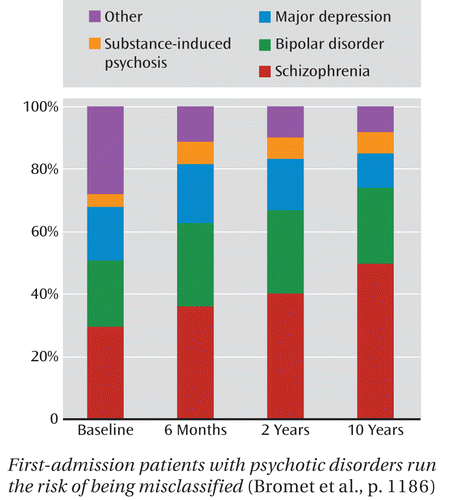In This Issue
Clinical Guidance: Stability of Diagnosis of First-Episode Psychosis
Diagnosis of schizophrenia or bipolar disorder in the first episode of psychosis had remarkable stability over a decade in the Bromet et al. (p. Original article: 1186) study of over 450 patients. Nearly 90% of patients initially diagnosed with schizophrenia and 80% of those diagnosed with bipolar disorder retained that diagnosis. Many patients diagnosed with psychotic depression or other unspecified psychosis, as well as 15% of those initially diagnosed with bipolar disorder, were rediagnosed as having schizophrenia (figure), generally because of increasing negative symptoms and poor psychosocial function. Coryell points out (p. Original article: 1136) that hypomanic symptoms and a family history of bipolar disorder may help identify those with bipolar disorder in the first episode.

First-admission patients with psychotic disorders run the risk of being misclassified (Bromet et al., p. 1186)
Clinical Guidance: Risk of Mood Disorder During and After Pregnancy
Mood disorder in over 2,200 pregnancies of over 1,100 women was examined by Viguera et al. (p. Original article: 1179) to determine the risk for an episode. Among these women, 22.7% of those with bipolar disorder experienced an episode during pregnancy and 51.5% during the postpartum period. In comparison, 4.6% of those with unipolar disorder experienced an episode during pregnancy and 29.8% during the postpartum period. First lifetime episodes of mood disorder during the perinatal period occurred for 7.6% of women. Women who already had a mood disorder before their first pregnancy had the highest risk. These high risks are consistent with recommendations for close monitoring and continued treatment during and after pregnancy.
Clinical Guidance: Rechallenge of the Clozapine Patient With Eosinophilia
Patients who develop eosinophilia during clozapine treatment are at risk for organ damage, which occurs in patients with idiopathic eosinophilia, in which eosinophils are more than 1.5×109/liter for more than 6 months. A patient who became actively suicidal without clozapine but who had previously had eosinophilia during clozapine treatment prompted an attempted rechallenge by Roberts et al. (p. Original article: 1147). Treatment parameters for the slow titration of clozapine included maintaining eosinophils at less than 1.5×109/liter and monitoring for possible end organ involvement with ECG, echocardiogram, serum troponin, amylase, lipase, and pulmonary and renal function tests. The patient's eosinophils increased to a peak of 1.2×109/liter as the clozapine dose was increased to 150 mg/day during the first 4 weeks. Thereafter, the eosinophils decreased with clozapine maintained at the same dose. As eosinophils continued to decrease, he could eventually receive doses up to 400 mg/day.
Medical Management for the Mentally Ill
A 2-year program providing monthly medical care management to low-income patients with serious mental illness improved health outcomes and lowered costs. However, Druss et al. (CME, p. Original article: 1171) discovered that the program was not financially sustainable, as only 40.5% of the patients had Medicaid or other insurance. The editorial by Sharfstein (p. Original article: 1134) describes how the Affordable Care Act could help integrate mental health and other medical care.
Trajectories of ADHD
Two studies of attention deficit hyperactivity disorder (ADHD) highlight long-term outcomes. The meta-analysis of brain imaging studies by Nakao et al. (CME, p. Original article: 1154) confirmed that gray matter volume deficits are less abnormal for patients taking stimulants and for adults with the disorder. The latter finding suggests that development may “catch up” as the patient ages. The longitudinal study of 2,000 children by Pingault et al. (p. Original article: 1164) revealed that inattention, but not hyperactivity, is related to whether children graduate from high school. Of those with inattentive behaviors enduring from age 6 to 12, only 29% graduated from high school. Hyperactivity was not independently associated with graduation. In an editorial, Gau (p. Original article: 1131) notes that another ADHD dimension, impulsivity, may also influence educational attainment.



